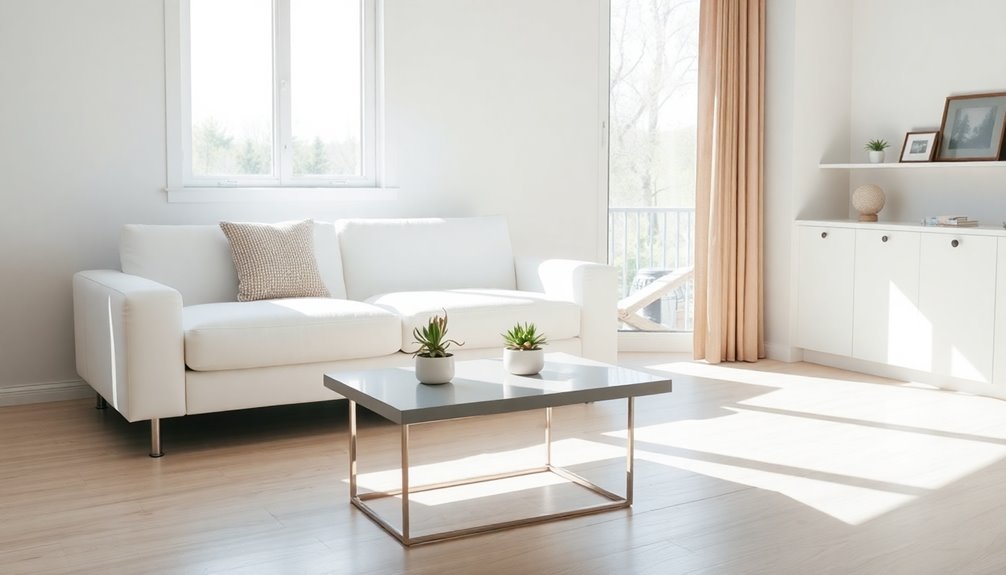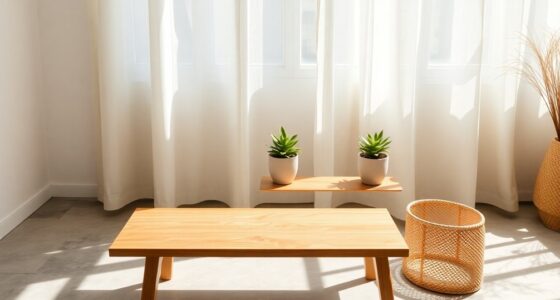To declutter your home and embrace minimalism, start by evaluating your belongings and identifying items that cause stress. Use effective strategies like the room-by-room approach and the 4-box method to categorize what to keep, donate, or recycle. Ask yourself essential questions about each item's value and impact on your life. Act quickly to remove sorted items and schedule regular decluttering sessions. As you begin this journey, you'll discover more tips to maintain a clutter-free space.
Key Takeaways
- Start by assessing your belongings using key questions to identify stressors and unnecessary items for decluttering.
- Use the 4-box method to categorize items into donate/sell, garbage, recycling, and keep for efficient sorting.
- Adopt a room-by-room approach to maintain focus and achieve momentum in your decluttering efforts.
- Establish a clutter-free maintenance routine by scheduling regular decluttering sessions and implementing a one in, one out rule.
- Engage with online resources and communities for support, motivation, and practical advice on your minimalist journey.
Understanding Minimalism and Its Benefits
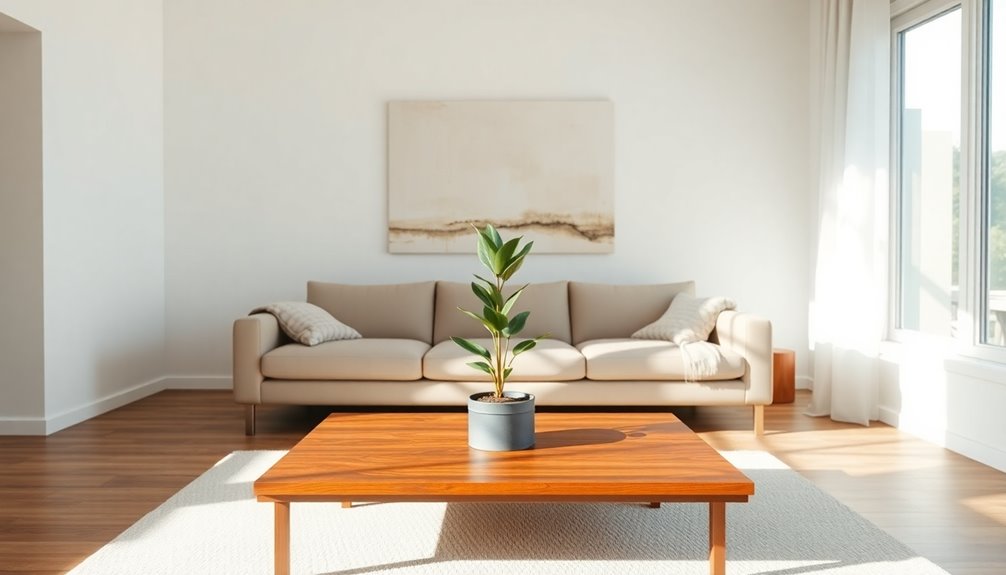
Minimalism offers a revitalizing clarity that can transform your living space and mindset.
By adopting a minimalist lifestyle, you can experience the benefits of decluttering your home. This approach encourages you to let go of unnecessary possessions, allowing you to focus on what truly adds value to your life.
As you simplify your surroundings, you'll find greater mental clarity and reduced overwhelm, creating a peaceful, organized environment that enhances your overall well-being.
Embracing minimalism not only supports your mental health but also promotes sustainability by reducing consumption and waste. Furthermore, the rise of generative AI in media has shown how technology can aid in creative processes, paralleling the minimalist ethos of efficiency and intentionality.
Ultimately, this intentional way of living minimizes distractions, enabling you to prioritize meaningful activities and personal growth.
Start your journey to a more fulfilling life through minimalism today.
Assessing Your Belongings: The First Step

Embracing a minimalist lifestyle sets the stage for the next important step: evaluating your belongings.
Start by reviewing your belongings and identifying items that cause stress or frustration, as these can hinder your decluttering journey. Look for duplicates or broken items—getting rid of these unnecessary pieces creates space and reduces clutter.
Consider your emotional attachments; ask yourself if an item adds value to your life. Use specific questions to guide your review, like whether you've used an item in the last six months or if you'd miss it.
Reflect on your emotional ties to belongings; determine if they enhance your life by asking if they're truly valuable.
Prioritize areas that offer immediate satisfaction, like junk drawers, to build momentum. Additionally, think about how watering techniques can simplify the care of your indoor plants, ensuring they remain a source of joy rather than clutter.
Choosing Your Starting Point for Decluttering

When you're ready to start decluttering, pick a small area that feels manageable, like a junk drawer or a flat surface. This approach not only makes the task less intimidating but also gives you quick wins that boost your motivation. Additionally, setting specific savings goals can help you focus on the value of the items you choose to keep or discard.
Identify Clutter Hotspots
Have you ever wondered why certain areas in your home seem to attract clutter like a magnet?
These clutter hotspots—like junk drawers, countertops, and stuffed closets—tend to accumulate disorganization quickly. Start by evaluating your space and pinpointing the areas that frustrate you the most; these are likely your key clutter hotspots.
Once identified, use the 4-box method: designate boxes for items to keep, donate or sell, recycle, and throw away. This systematic approach helps you focus on letting go of what you no longer need.
Regularly revisiting these hotspots can prevent future clutter accumulation, keeping your home organized and supporting your minimalist lifestyle. Consider incorporating preppy dog names for your furry friends, as they can add a touch of style to your life.
Embrace the process and enjoy the immediate satisfaction of a decluttered space!
Start Small Areas
Starting with small areas can make a big difference in your decluttering journey. Tackling manageable spaces like a junk drawer or a single shelf helps you avoid feeling overwhelmed and lets you experience quick wins.
Here are some tips to effectively start small areas:
- Choose frequently used or visible spots to maximize impact.
- Use the 4-box method: donate/sell, garbage, recycling, and keep.
- Schedule brief sessions, like 15-30 minutes, to maintain focus. Additionally, incorporating the Montessori-inspired approach can help create a more organized and functional space as you declutter.
Effective Decluttering Strategies and Techniques
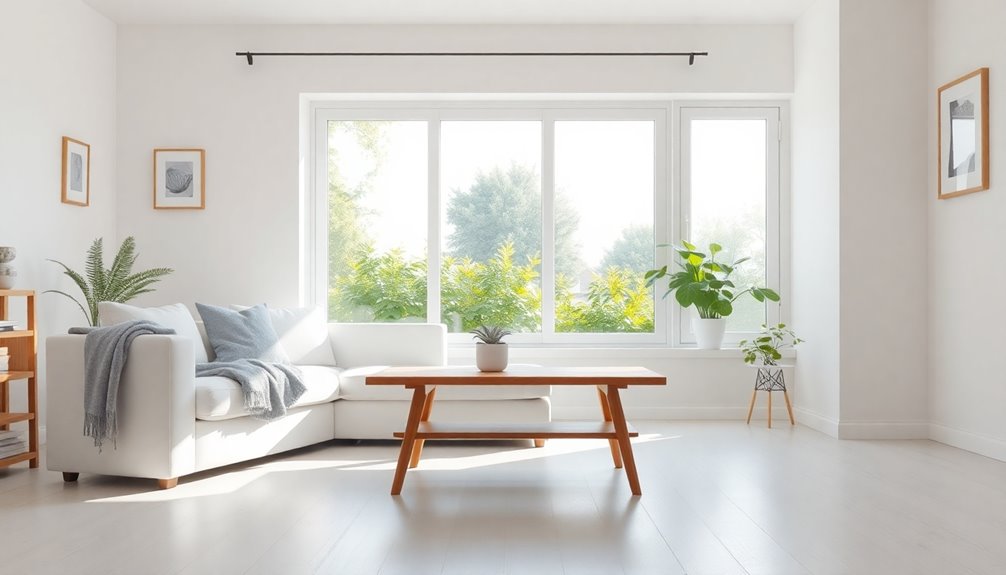
To really tackle decluttering, try a room-by-room approach that keeps you focused and organized.
Ask yourself key questions about each item to help you determine its value and whether it deserves a place in your home. Consider implementing the best professional hair color brands to ensure that you keep only items that truly enhance your living space.
Room-by-Room Approach
When you tackle decluttering, a room-by-room approach can make the process feel less overwhelming and more manageable.
Start with areas that offer quick wins, like a junk drawer or flat surface. Use the 4-box method to sort items into categories:
- Donate/Sell
- Garbage
- Recycling
For items you're unsure about, consider the PENALTY BOX tactic—place them in a designated box for 1, 3, or 6 months before reassessing.
Celebrate each room's completion to boost your motivation and recognize your progress. Gradually move to tougher spaces, ensuring you handle items promptly to avoid lingering donation piles. Additionally, establishing a functional layout can help maintain an organized space after decluttering.
This room-by-room strategy keeps your decluttering on track and focused.
Decluttering Questions Guide
As you move forward with your decluttering journey, asking the right questions can greatly enhance your decision-making process. Start by using decluttering questions like, "Does this add value to my life?" and "Have I used this in the last six months?" These help you assess the necessity of items, guiding you toward a minimalist home.
Look for duplicates and unitaskers, as they often create unnecessary clutter. The four-box method—donate/sell, garbage, recycling, and keep—can streamline your sorting. Focus on mini goals by tackling one small area at a time to avoid feeling overwhelmed.
Finally, recognize that emotional attachments can hinder your progress; consider taking photos of sentimental items to preserve memories while letting go of physical clutter. Additionally, practicing mindful decluttering strategies can help maintain organization and prevent future clutter buildup.
Essential Questions to Guide Your Decluttering Process
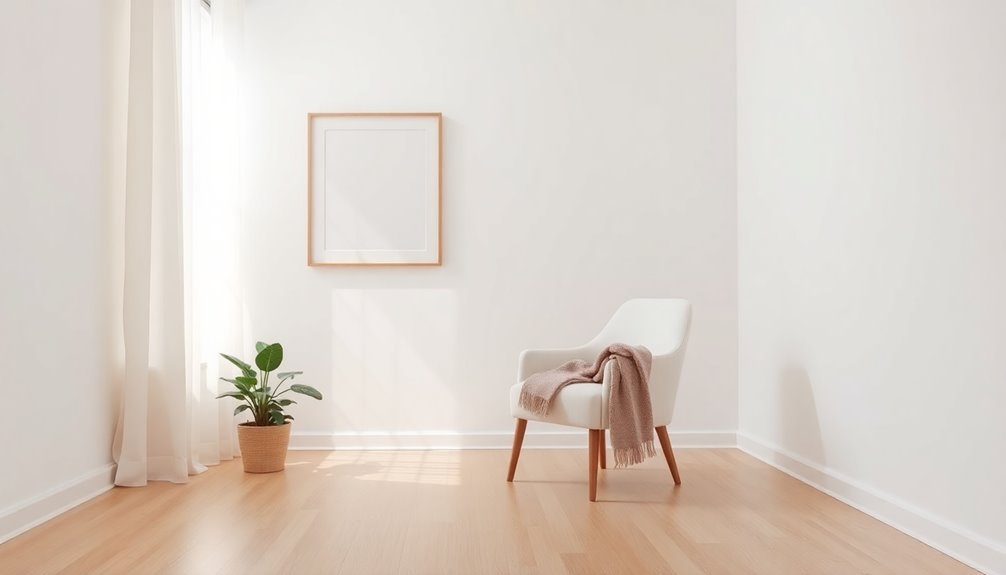
How can you determine what truly deserves a place in your home? Start by asking yourself essential decluttering questions to guide your process. Reflect on each item's emotional value and its role in your life.
Consider these criteria:
- Have I used this item in the last six months?
- Does it contribute to my happiness, health, or productivity?
- Is it truly valuable, or just a "what if" remnant of the past?
Engaging with these questions regularly can streamline your path to a minimalist lifestyle. Incorporating sustainable materials into your decor can also encourage mindful choices about what you keep and what you let go.
By prioritizing what matters, you'll find it easier to let go of unnecessary items and create a home that feels more intentional and serene.
Embrace the clarity that comes with mindful decluttering!
Room-by-Room Decluttering Approach

A room-by-room decluttering approach can make the process feel manageable and rewarding. Start with easier spaces, like a junk drawer, to build momentum before tackling more challenging areas.
Use the 4-box method: designate boxes for donate/sell, garbage, recycling, and keep. This helps streamline sorting and keeps you focused.
Celebrate your progress after each room; a simple high-five or a favorite treat can keep your motivation high.
For items you can't decide on, try the "Penalty Box" tactic—store them for a set period and revisit your decisions later.
Embracing this structured approach to decluttering not only helps you achieve minimalism in your home but also allows you to enjoy the journey along the way. Additionally, consider how routine health checks can help maintain the overall well-being of your living space by identifying items that may be contributing to clutter or disorganization.
Post-Decluttering Actions and Maintenance

Maintaining a clutter-free home requires consistent effort and intentional habits.
After your post-decluttering session, act quickly to remove sorted items from your home. This helps prevent second-guessing and the reaccumulation of clutter.
Here are some strategies to help you maintain the newfound order:
- Schedule regular decluttering sessions every season.
- Implement the one in, one out rule for items in your home.
- Reassess your belongings monthly to verify they still bring you joy.
Resources for Continued Minimalist Living
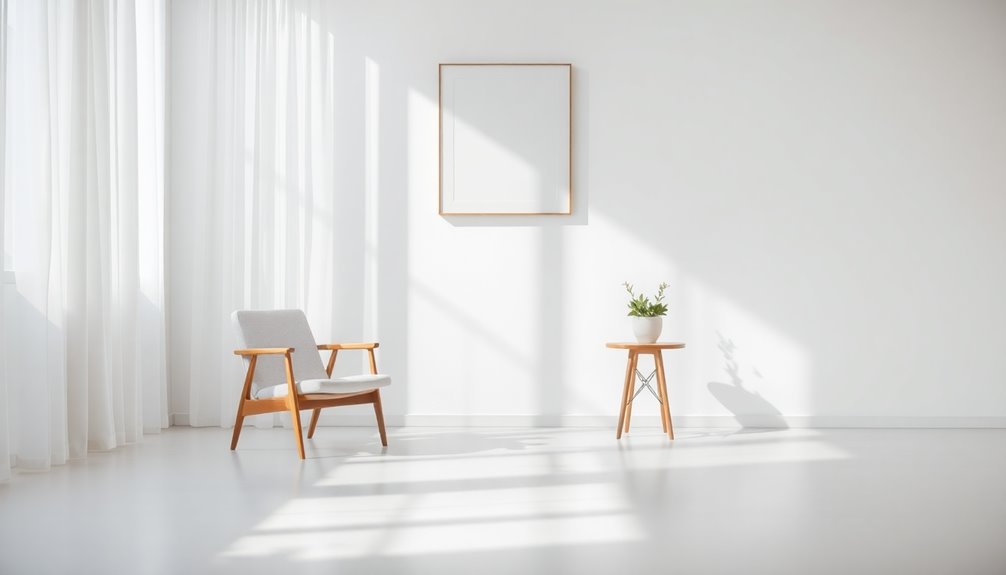
While embracing a minimalist lifestyle can feel overwhelming at first, numerous resources can help you thrive on this journey.
The good news is that online communities, like the r/minimalism subreddit, offer valuable support and shared experiences. You might also consider letting decluttering apps like Sortly or Clutterfree track your possessions, making organization easier.
Online communities and decluttering apps can provide essential support and organization on your minimalism journey.
Reading books such as "The Life-Changing Magic of Tidying Up" by Marie Kondo can provide deeper insights into minimalism for your home. Additionally, following blogs and YouTube channels like The Minimalists can inspire you with practical advice.
Finally, schedule regular decluttering sessions every few months to reassess your belongings and keep your space aligned with your minimalist goals.
Frequently Asked Questions
What Is the 20/20/20 Rule for Decluttering?
The 20/20/20 rule for decluttering states that if you can replace an item for $20 or less and get it within 20 minutes, you can let it go without much worry.
This helps you make quick decisions and reduces emotional attachment to less important things.
What Is the 90-90 Rule for Minimalism?
When you're surrounded by items you rarely use, it's easy to feel overwhelmed.
That's where the 90-90 Rule comes in. You ask yourself if you've used an item in the last 90 days or if you'll use it in the next 90 days.
If the answer's no to both, it's probably time to let it go. This simple test helps you declutter effectively, creating a space that truly reflects your needs.
What Is the 30/30 Rule for Minimalists?
The 30/30 Rule for minimalists suggests that if you haven't used an item in the last 30 days and it costs $30 or less to replace, it's time to let it go.
This approach helps you evaluate your belongings without emotional attachment. By focusing on inexpensive items you rarely use, you streamline your decluttering process, making decisions quicker and creating a more organized space that truly reflects what adds value to your life.
What Is the 80/20 Rule in Minimalism?
Did you know that 80% of your happiness often comes from just 20% of your possessions?
That's the essence of the 80/20 rule in minimalism. You focus on identifying the few items that truly enrich your life, rather than getting bogged down by everything else.
Conclusion
In the journey to declutter your home, remember the adage, "Less is more." Embracing minimalism isn't just about getting rid of things; it's about creating a space that reflects your true self and brings you joy. As you maintain your newly organized environment, keep focusing on what truly matters. By continually reassessing your belongings and lifestyle, you'll find peace and clarity in simplicity, making your home a sanctuary that nurtures your well-being.
